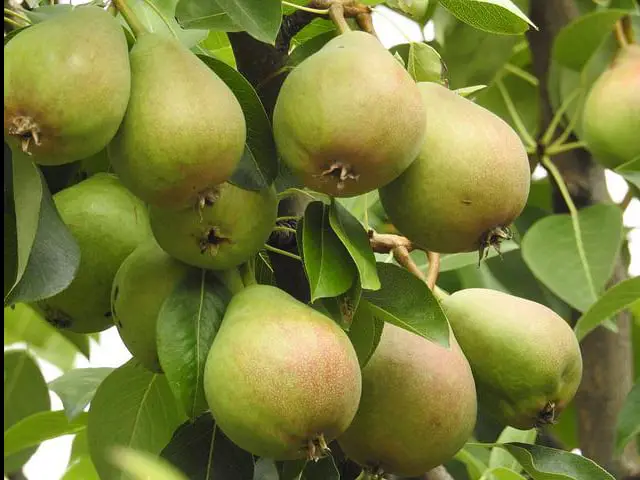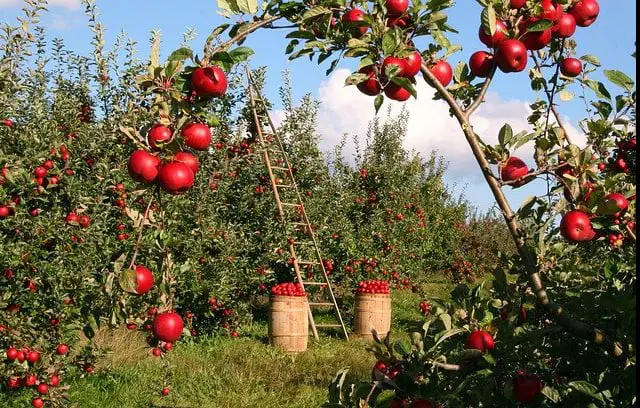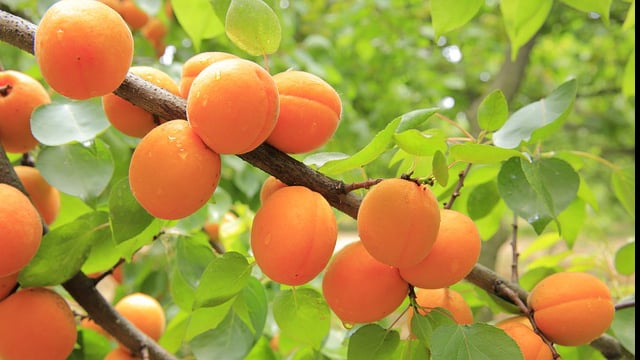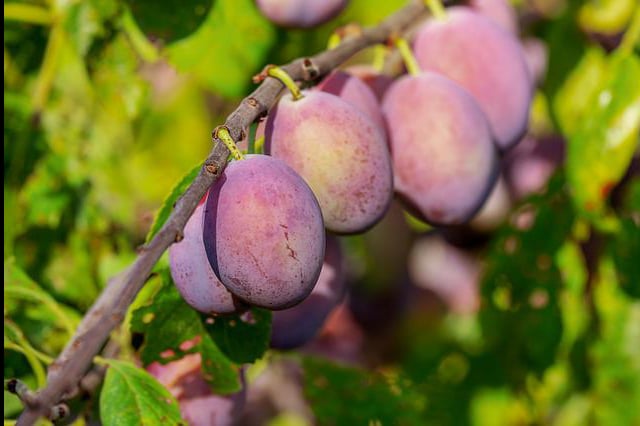When you think of fruit trees, what comes to mind? Probably apples, pears, and cherries. But did you know that there are fruit trees that grow at high altitudes?
In this blog post, we’ll explore some of the most popular fruit trees that can be grown at high elevations.
What Fruit Trees Grow at High Altitudes?
Fruit trees that grow at high altitudes include apples, apricots, pears, plums, sour cherries, and greenhouse trees. The higher the altitude, the shorter the growing season, so not all fruit trees will grow at high altitudes.
For example, peach trees can’t tolerate cold temperatures and won’t do well above 7,000 feet elevation.
Pears
Yes, pears can grow at high altitudes. They are one of the hardier fruit trees and can tolerate colder temperatures than most other fruit trees.
Pear trees grown at high altitudes tend to be smaller than those grown at lower elevations, but they will still bear fruit.
The main thing to remember when growing pears at high altitudes are to find early ripening varieties. Most ripen late (ever seen a fully ripe pear in the supermarket, ha!).

Some great pears that ripen in August include:
- Clapp’s Favorite
- Honeysweet
- Moonglow
- Summercrisp
For a full list see Idaho’s Extension Service’s writeup here.
Apples
So, can apples grow at high altitudes? The answer is yes! Apples are native to mountains and plateaus of central Asia (source). They were first cultivated in these regions, so they are well-suited to growing in high-altitude climates.
In fact, due to climate change, apple growers in the Himalayas have been moving their orchards to higher elevations (source).

One reason thples can grow so well at high altitudes is bethathey are hardy fruit. They can withstand cold temperatures and survive hardships that other fruits would not survive.
So, if you’re looking to grow apples at a high altitude, know that it is possible! Just make sure you choose a dwarf variety that is known to be tolerant of cold weather conditions and shorter growing seasons.
Apple varieties that do well in a short season, high altitude climates include:
- Earligold
- State Fair
- Hazen
- Liberty
- McIntosh
Apricots
Late-blooming early maturing dwarf varieties can grow at high altitudes. They will usually flower later and mature earlier than standard apricot trees, so they are a good option for areas that have a shorter growing season. Dwarf apricots are also less prone to frost damage than standard apricots.
Be warned that many varieties of apricots bloom early so be on the lookout only for late-blooming forms.

Short season, early blooming apricots that do well include:
- Chinese (Mormon)
- Harcot – late blooming
- Harlayne
- Perfection
- Sungold
Plums
Yes, plums can grow at high altitudes, but you’ll need to find an early ripening variety.
Plums are a bit sensitive to cold weather, so most varieties won’t do as well in colder climates or at higher elevations.
Instead, look for early ripening European varieties or cold-hardy hybrids (source). Japanese varieties tend to be less-cold hardy though Methley’s ripen in August and may work for your area.

European Plum Varieties for High Altitudes:
- Mount Royal
- Stanley
- Underwood
- Ember
- Italian
Hybrid Plum Varieties for High Altitude:
- Sapalta
- Alderman
- Toka
- Tecumseth
Sour Cherries
Yes, sour cherries (aka tart cherries) can grow at high altitudes. They are very cold hardy but flower early.
Meteor, Northstar, and Montmorency varieties all do well at high altitudes. Just be mindful of their early flowering. You will lose crops with early frosts some years.
Growing Greenhouse Trees at Altitude
If you’re looking for fruit trees that can be grown in a greenhouse at a high altitude, then you have more options but you’ll still need early maturing varieties since you’ll still have shorter growing seasons.
The biggest benefit a greenhouse gives is protecting blossoms from early frost. This will help ensure that early flowering cherries or apricots don’t get nipped and can still bear fruit.
Other Considerations – Hardy Root Stock
There are a few other things to consider when growing chocolate trees. One is the need for a cold-hardy rootstock. Even though you bought a short-season tree it might be grafted onto a warm-season rootstock.
Instead, you want to make sure it’s grafted onto a cold-hard one like the Russian Bud 9 rootstock or the Russian Antanovka rootstock. These rootstocks can help keep your tree healthy and productive in colder climates.
Another consideration is dwarfing rootstocks vs semi-dwarf or standard rootstocks.
While dwarf varieties allow you to plant more types of fruit trees in a small yard and they start bearing fruits earlier (fewer years to big harvests), a dwarfing rootstock is less hardy.
Make sure you get a cold-hardy variety that was grafted onto either one of the Russian rootstocks above or onto a semi-dwarf or standard tree rootstock.
Other Considerations – What is alternate bearing?
Alternate bearing is the tendency of a plant to bear more fruit one year and less fruit the next. This occurs because the plant is expending most of its resources on growing during the “on” year then not enough resources to produce excess buds for the next year.
The solution is hand thinning. Remove all but one fruit from a bunch and make sure fruits are spaced 4-6 inches apart on the branch.
This will give the tree more space and resources to produce buds that become blooms and eventually fruit for the following year.
Other Considerations – How Do You Protect Blooms from Frost?
There are a few ways to protect your blooms from frost. One option is to use heaters, lamps, or charcoal briquets. However, this method can only be used if there is no wind. If there is wind, the warmth created by the heaters, lamps, or charcoal briquets will be blown away and not do any good.
Another option is to cover your plants with blankets or sheets. However, this only works for smaller dwarf trees where you can easily reach the top.
Other Considerations – Small Fruits
When it comes to preventing small fruits, thinning is key. By thinning the fruits on your trees, you can both prevent alternate bearing and create larger fruits. If you’re seeing a heavy setting of fruits then remove most of them by hand and leave them spaced out 4-6 inches apart.
Other Considerations – Fewer Pollinators
High altitude areas naturally have fewer insects which means fewer pollinators. This gets worse during highly wet or cold springs which can reduce this number even further.
One solution is to plant a variety of flowering plants that attract pollinators like bees and wasps. Another solution is to hand pollinate the flowers yourself.
The easiest solution is to choose self-pollinating varieties.
What Fruit Trees Can You Grow in The High Desert (5,000′)?
The high desert is a great place to grow fruit trees because it has hot summers and cold winters. Plus it’s the lower elevation of 5,000′ lets you grow varieties that won’t work in the high Rockies.
Some of the fruit trees that you can grow in the high desert are apples, apricots, cherries, nectarines, peaches, pears, and plums.
If you are looking for a fruit tree that is resistant to drought, then you should consider planting an apricot tree. Apricots require very little water, especially when grafted on apricot rootstock.
Conclusion
There are a variety of fruit trees that you can grow in high-altitude areas. The key is to choose a cold-hardy variety that is grafted onto a cold-hardy rootstock. Other considerations include hand thinning, protecting blooms from frost, and planting self-pollinating varieties. With these tips, you can successfully grow fruit trees in high-altitude areas.


